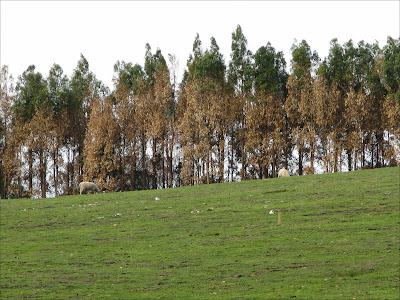To properly
address bushfire risk it’s important to understand what actually burns as fire
moves across the landscape, especially as the Victorian Fire Risk Register –
Bushfire (VFRR-B) is being raised by the CFA and certain municipal councils to
‘influence’ planning permit application decisions. I’ll come back to this later as not
properly understood the Risk Register has the potential to unnecessarily frighten people and
lead to poor decision-making.
Extending
on from my 15 June posting “Bushfire explained – Part 2” (click here) following are some examples of unburnt vegetation in the path of bushfire, beginning with trees in the vicinity of the Lancefield–Kilmore Road, mid-way between Lancefield and Kilmore, as the 9 February Mickleham fire (click here) travelled north.
Roadside
eucalypts on the sides of the Lancefield–Kilmore Road showing predominantly
only canopy or “crown” scorch. It would have been a ‘hot’ fire that
passed beneath those trees, but not hot enough to ignite the canopies.
Remember, this is the fire that took several days to control.
Below are trees
in open fields south of the Lancefield–Kilmore Road showing only “crown”
scorch.
Below
are trees and shrubs in the path of the 9 February 2014 Gisborne fire as it travelled northeast
towards Riddells Creek after the wind change. The fire weather conditions this
day were described as being the worst since 7 February 2009 (Black Saturday).
Above, trees and low vegetation "scorched" as the fire continued its rush towards Riddells Creek having crossed the Sunbury-Riddells Creek Road just visible at right.
In the photographs immediately above and below this text observe how the fire only "scorched" the base of these tree trunks, except for where it took hold on an open section of the trunk in a tree in the lower photograph. This burning section of trunk would not have been part of the fire front.
Finally,
some well established Pines near Gisborne (courtesy Haydn Bishop Electrics, Gisborne) that did not succumb to crown fire. Insufficient
fine fuel around the base of these trees and lack of trunk fine fuel (needles) kept the
fire at ground level. Relevant to earlier photographs of "scorched" Pines.
I’m
hoping by now that it’s becoming apparent that trees don’t automatically burn and
thus don’t contribute significantly to the intensity of bushfire; indeed in
some circumstances trees can actually help shield a building from radiant heat
and reduce ember attack. I’ll continue this theme in my next posting as it’s
important, particularly in understanding how the Victorian Fire Risk Register –
Bushfire (VFRR-B) seems to deal with bushfire and how that Risk Register is being
applied.












No comments:
Post a Comment